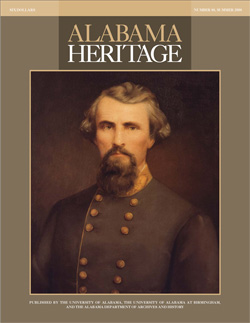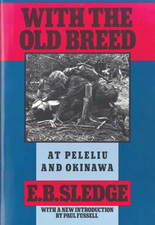|
On the cover: Gen. Nathan Bedford Forrest led a grueling attack on the Union supply hub of Sulphur Trestle Fort. (Courtesy the Alabama Department of Archives and History.)
|
FEATURE ABSTRACTS
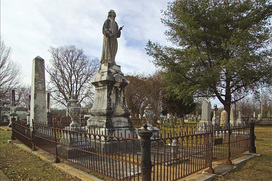 The McLester family plot at Greenwood Cemetery
The McLester family plot at Greenwood Cemetery (Robin McDonald)
Teaching Tombstones in Tuscaloosa County
By Ian W. Brown
As professor of an anthropology course taught in the cemeteries of Tuscaloosa County each year, Ian Brown sees cemeteries as outdoor classrooms. Providing a wealth of historical, anthropological, and sociological information, tombstones have long been an invaluable resource to historians, genealogists, art historians, and archaeologists. Not only does each marker tell the story of a life, it also tells the story of the time during which the marker was made. Join him as he traces the tale of Tuscaloosa markers and carvers using a mixture of detective work and determination.
Additional Information
See our collection of Alabama "story" tombstones from our readers.
Multimedia:
About the Author
Ian W. Brown, a professor of anthropology at the University of Alabama, specializes in the archaeology and history of southeastern Indians. He has spent almost four decades excavating sites in Louisiana, Mississippi, and Alabama. In terms of cemetery research, he and his students have been conducting a long-term study of the historic and modern burial grounds of Tuscaloosa County, known as "The Marking Graves Project.” Dr. Brown is also a member of the Board of Trustees for the Association for Gravestone Studies.
By Ian W. Brown
As professor of an anthropology course taught in the cemeteries of Tuscaloosa County each year, Ian Brown sees cemeteries as outdoor classrooms. Providing a wealth of historical, anthropological, and sociological information, tombstones have long been an invaluable resource to historians, genealogists, art historians, and archaeologists. Not only does each marker tell the story of a life, it also tells the story of the time during which the marker was made. Join him as he traces the tale of Tuscaloosa markers and carvers using a mixture of detective work and determination.
Additional Information
See our collection of Alabama "story" tombstones from our readers.
- For those interested in learning more about what can be done to protect cemeteries, Brown recommends A Graveyard Preservation Primer by Lynette Strangstad (AltaMira Press, 1995).
- Gregory Jeane’s article “The Upland South Folk Cemetery Complex: Some Suggestions of Origin” (in Cemeteries and Gravemarkers: Voices of American Culture, edited by Richard E. Myer, Utah State University Press, 1992) provides excellent background on the uniqueness of burial patterns in the interior of the Deep South.
- For Tuscaloosa County carvers, a very good source is “An Overview of 19th Century Alabama Tombstones and Their Makers” (the Southern Quarterly 1993).
- And for basic background on what can be learned about society by studying carvers, one can do no better than reading Chapter 4 in James Deetz’s In Small Things Forgotten: An Archaeology of Early American Life (Anchor Books Doubleday, 1996).
Multimedia:
About the Author
Ian W. Brown, a professor of anthropology at the University of Alabama, specializes in the archaeology and history of southeastern Indians. He has spent almost four decades excavating sites in Louisiana, Mississippi, and Alabama. In terms of cemetery research, he and his students have been conducting a long-term study of the historic and modern burial grounds of Tuscaloosa County, known as "The Marking Graves Project.” Dr. Brown is also a member of the Board of Trustees for the Association for Gravestone Studies.
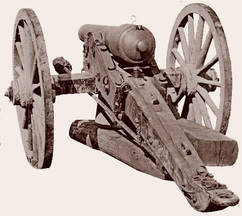 A Parrott gun
A Parrott gun(Library of Congress)
Five Hours At Sulphur Trestle Fort
By Thomas V. Ress
During the dawn hours of September 25, 1864, a meager Union barracks known as Sulphur Trestle Fort began to tremble under attack from Confederate cannons. This small site near Elkhart in Limestone County was constructed to protect federal railroad supply lines. Confederate Gen. Nathan Bedford Forrest led the fierce onslaught, recognizing a prize when he saw one.
By Thomas V. Ress
During the dawn hours of September 25, 1864, a meager Union barracks known as Sulphur Trestle Fort began to tremble under attack from Confederate cannons. This small site near Elkhart in Limestone County was constructed to protect federal railroad supply lines. Confederate Gen. Nathan Bedford Forrest led the fierce onslaught, recognizing a prize when he saw one.
Additional Information
About the Author
Thomas V. Ress resides in Athens, Alabama. He is a freelance writer and has had dozens of articles published in numerous magazines, newspapers, and websites including Discovery.com, SKI, Backpacker, and Southeastern Outdoor Recreation, among others. He was formerly a community columnist for the Huntsville Times. Ress grew up in southern Indiana and received his BS from the University of Evansville (IN) and his MBA from Eastern Kentucky University. He currently does consulting work for the federal government. The author wishes to thank Richard Martin for being an invaluable resource.
- Brief History of Lilly’s Battery (18th Indiana Lt. Art.). (New South Publishing, 2003).
- Davison, Eddy W. and Daniel Foxx, Nathan Bedford Forrest, In Search of the Enigma. (Pelican Publishing, 2007).
- Dunnavant, Robert, Jr. Historic Limestone County. (Pea Ridge Press, 1995).
- _____. The Railroad War. )Pea Ridge Press, 1994).
- Foote, Shelby. The Civil War: A Narrative, Red River to Appomattox. (Vintage Books, 1974).
- Harris, W. Stuart. Dead Towns of Alabama. (University of Alabama Press, 1977).
- Henry, Robert Selph. As They Saw Forrest. (McCowat-Mercer Press, 1956).
- Hurst, Jack. Nathan Bedford Forrest: A Biography. (Alfred A. Knopf, 1993).
- Lytle, Andrew Nelson, J. Sanders, and Company. Bedford Forrest and His Critter Company. (1931).
- Wyeth, John Allen. That Devil Forrest: The Life of General Nathan Bedford Forrest. (LSU Press, 1959).
About the Author
Thomas V. Ress resides in Athens, Alabama. He is a freelance writer and has had dozens of articles published in numerous magazines, newspapers, and websites including Discovery.com, SKI, Backpacker, and Southeastern Outdoor Recreation, among others. He was formerly a community columnist for the Huntsville Times. Ress grew up in southern Indiana and received his BS from the University of Evansville (IN) and his MBA from Eastern Kentucky University. He currently does consulting work for the federal government. The author wishes to thank Richard Martin for being an invaluable resource.
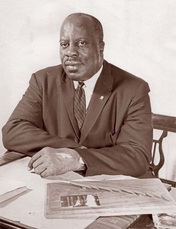 Emory O. Jackson, managing editor of the "Birmingham World" (Birmingham Public Library)
Emory O. Jackson, managing editor of the "Birmingham World" (Birmingham Public Library)
Emory O. Jackson: The Voice of Black Birmingham
By Mary Stanton
Emory O. Jackson, managing editor of the Birmingham World and the Executive Secretary of Birmingham’s NAACP chapter used these platforms to educate and influence black citizens on a variety of racial issues for over thirty years. Championing the black voter participation, Jackson shunned apathy and encouraged readers to fight for economic and scholastic equality within the framework of law and order. Both a spitfire and a moderate, Jackson was, for decades, the “Voice of Black Birmingham.”
By Mary Stanton
Emory O. Jackson, managing editor of the Birmingham World and the Executive Secretary of Birmingham’s NAACP chapter used these platforms to educate and influence black citizens on a variety of racial issues for over thirty years. Championing the black voter participation, Jackson shunned apathy and encouraged readers to fight for economic and scholastic equality within the framework of law and order. Both a spitfire and a moderate, Jackson was, for decades, the “Voice of Black Birmingham.”
Additional Information
About the Author
Mary Stanton is a historian whose primary interest is white civil rights activism. Stanton has taught at the University of Idaho, the College of St. Elizabeth, and Rutgers University. Her articles have appeared inSouthern Exposure, Gulf South Historical Review, Alabama Heritage, Callaloo, Studies in Religion, and Southern Jewish History. She lives in New York City and works as an administrator for the Town of Mamaroneck in Westchester County.
- Clark, E. Culpepper. The Schoolhouse Door: Segregation’s Last Stand. (Oxford University Press, 1993).
- Connerly, Charles E. The Most Segregated City In America: City Planning and Civil Rights In Birmingham 1920–1980. (University of Virginia Press, 2005).
- Feldman, Lynne. A Sense of Place: Birmingham’s Black Middle Class Community, 1890–1930. (University of Alabama Press, 1999).
- McWhorter, Diane. Carry Me Home: Birmingham, Alabama, The Climactic Battle of the Civil Rights Revolution. (Simon & Schuster, 2001).
- Roberts, Gene and Hank Klibanoff. The Race Beat: The Press, the Civil Rights Struggle and The Awakening of the Nation. (Alfred Knopf, 2007).
- Stanton, Mary. Journey Toward Justice: Juliette Hampton Morgan and The Montgomery Bus Boycott. (University of Georgia Press, 2006).
- Stanton, Mary. The Hand Of Esau: Montgomery’s Jewish Community and the Bus Boycott. (River City Publishing, 2006).
- Stanton, Mary. From Selma To Sorrow: The Life and Death of Viola Liuzzo. (University of Georgia Press, 1998).
- _____. Freedom Walk. (The University Press of Mississippi, 2004).
- Emory O. Jackson
- The Civil Rights Movement in Alabama (feature)
- Montgomery Bus Boycott
- National Association for the Advancement of Colored People in Alabama (NAACP)
About the Author
Mary Stanton is a historian whose primary interest is white civil rights activism. Stanton has taught at the University of Idaho, the College of St. Elizabeth, and Rutgers University. Her articles have appeared inSouthern Exposure, Gulf South Historical Review, Alabama Heritage, Callaloo, Studies in Religion, and Southern Jewish History. She lives in New York City and works as an administrator for the Town of Mamaroneck in Westchester County.
 UAB campus recreation center
UAB campus recreation center (M. Lewis Kennedy Jr.)
Creating Community In Alabama
By Alice Meriwether Bowsher
Photography by M. Lewis Kennedy Jr.
Through breathtaking photos, examine how elements of design can enhance a community’s identity, values, and connectedness. Bowsher examines the consequences of modern car-dependent communities and looks at what can be gained by rediscovering the roots of traditional city landscaping: centers and town squares that highlight walkability and unique buildings with regional flavor that serve the individual needs of their towns.
By Alice Meriwether Bowsher
Photography by M. Lewis Kennedy Jr.
Through breathtaking photos, examine how elements of design can enhance a community’s identity, values, and connectedness. Bowsher examines the consequences of modern car-dependent communities and looks at what can be gained by rediscovering the roots of traditional city landscaping: centers and town squares that highlight walkability and unique buildings with regional flavor that serve the individual needs of their towns.
Additional Information
For further reading:
About the Author
Bowsher’s latest book is Community in Alabama: Architecture for Living Together, published by the Alabama Architectural Foundation. It is a sequel to her earlier book, Alabama Architecture: Looking at Building and Place, published by the University of Alabama Press. She serves as an architectural historian on the National Register Review Board of the Alabama Historical Commission and is an Alabama Advisor Emeritus to the National Trust for Historic Preservation. She has been active in historic preservation in the state for the past twenty-five years.
M. Lewis Kennedy Jr. has more than two decades experience as a professional photographer, concentrating on architectural and industrial subjects, particularly in Alabama and the Southeast. He is the photographer for the book Alabama Architecture.
For further reading:
- Bowsher, Alice. Alabama Architecture: Looking at Building and Place. Photographer M. Lewis Kennedy. Fwd. by Charles A. Moss. (University of Alabama Press, 2001).
- ____. Community in Alabama: Architecture for Living Together. Photographer M. Lewis Kennedy. (Alabama Architectural Foundation, 2007).
About the Author
Bowsher’s latest book is Community in Alabama: Architecture for Living Together, published by the Alabama Architectural Foundation. It is a sequel to her earlier book, Alabama Architecture: Looking at Building and Place, published by the University of Alabama Press. She serves as an architectural historian on the National Register Review Board of the Alabama Historical Commission and is an Alabama Advisor Emeritus to the National Trust for Historic Preservation. She has been active in historic preservation in the state for the past twenty-five years.
M. Lewis Kennedy Jr. has more than two decades experience as a professional photographer, concentrating on architectural and industrial subjects, particularly in Alabama and the Southeast. He is the photographer for the book Alabama Architecture.
DEPARTMENT ABSTRACTS
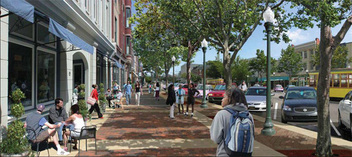 The pedestrian town center in Montgomery
The pedestrian town center in Montgomery(Christy Anderson)
Southern Architecture and Preservation
The “New Urbanism” In Montgomery
By Christy Anderson
Ratified in 1996, the Charter of the New Urbanism seeks to restore existing urban areas, preserve historic streetscapes, and encourage new architecture and development that ensures walkable, mixed-used communities that are compatible with existing architecture. Local tradition, climate, and current landscape all play into decisions regarding what to build, what to renovate, and what to protect. New Urbanism preserves interesting regional distinctions, making each city a unique place to walk, spend time, and live.
Additional Information
To get involved with Alabama’s Preservation:
Since 1994 the Alabama Historical Commission and the Alabama Trust for Historic Preservation have joined forces to sponsor “Places in Peril,” a program that each year highlights some of the state’s significant endangered properties. As awareness yields commitment, and commitment yields action, these endangered properties can be saved and returned to their important place as treasured landmarks.
The “Places in Peril” program has helped to save many important landmarks that might otherwise have been lost. These include the Forks of Cyprus ruins in Florence (listed 1997), the John Glascock House in Tuscaloosa (listed 2001), the Lowe Mill Village in Huntsville (listed 2002), the Coleman House in Uniontown (listed 2003), and Locust Hill in Tuscumbia (listed 2004).
Everyone can play a role to help save those resources that are in peril. Adopt one of the properties. Tell everybody you know that it is important. Write letters of support. Volunteer your time or expertise to the local preservation group. If one of the places really strikes you, go ahead and buy it! A generous (or even modest) donation to the “Endangered Property Trust Fund” can help statewide.
For more information on the fund or joining the Alabama Trust for Historic Preservation, call 205-652-3497 or visit them online. For additional information on the “Places in Peril” program, visit the Alabama Historical Commission website or contact Melanie Betz at 334-242-3184.
The following articles in the Encyclopedia of Alabama will also be of interest:
About the Author
Christy Anderson is the Preservation Planner for the City of Montgomery. Robert Gamble and Melanie Betz Gregory, architectural historians for the Alabama Historical Commission, serve as the standing editors of the “Southern Architecture and Preservation” department of Alabama Heritage.
The “New Urbanism” In Montgomery
By Christy Anderson
Ratified in 1996, the Charter of the New Urbanism seeks to restore existing urban areas, preserve historic streetscapes, and encourage new architecture and development that ensures walkable, mixed-used communities that are compatible with existing architecture. Local tradition, climate, and current landscape all play into decisions regarding what to build, what to renovate, and what to protect. New Urbanism preserves interesting regional distinctions, making each city a unique place to walk, spend time, and live.
Additional Information
To get involved with Alabama’s Preservation:
Since 1994 the Alabama Historical Commission and the Alabama Trust for Historic Preservation have joined forces to sponsor “Places in Peril,” a program that each year highlights some of the state’s significant endangered properties. As awareness yields commitment, and commitment yields action, these endangered properties can be saved and returned to their important place as treasured landmarks.
The “Places in Peril” program has helped to save many important landmarks that might otherwise have been lost. These include the Forks of Cyprus ruins in Florence (listed 1997), the John Glascock House in Tuscaloosa (listed 2001), the Lowe Mill Village in Huntsville (listed 2002), the Coleman House in Uniontown (listed 2003), and Locust Hill in Tuscumbia (listed 2004).
Everyone can play a role to help save those resources that are in peril. Adopt one of the properties. Tell everybody you know that it is important. Write letters of support. Volunteer your time or expertise to the local preservation group. If one of the places really strikes you, go ahead and buy it! A generous (or even modest) donation to the “Endangered Property Trust Fund” can help statewide.
For more information on the fund or joining the Alabama Trust for Historic Preservation, call 205-652-3497 or visit them online. For additional information on the “Places in Peril” program, visit the Alabama Historical Commission website or contact Melanie Betz at 334-242-3184.
The following articles in the Encyclopedia of Alabama will also be of interest:
About the Author
Christy Anderson is the Preservation Planner for the City of Montgomery. Robert Gamble and Melanie Betz Gregory, architectural historians for the Alabama Historical Commission, serve as the standing editors of the “Southern Architecture and Preservation” department of Alabama Heritage.
Alabama Mysteries
A Death In Conecuh County
By Pam Jones
Seventy-two-year-old farmer and Civil War veteran “Captain” Jesse Baldwin was beaten to death just steps from his back porch on the morning of July 8, 1910. The motive was simple robbery; it was known that Baldwin kept a great deal of cash in his home. Though one man was captured and convicted for the death just days later, it was widely believed that several men were responsible. The case went cold, but decades later they got a lead.
Additional Information
The following items in the Encyclopedia of Alabama will also be of interest:
About the Author
Pamela Jones is a freelance writer and researcher based in Birmingham. Her particular areas of interest in Alabama history are true crime and the state between the two world wars. She is a history instructor at a Birmingham college and writes corporate histories.
A Death In Conecuh County
By Pam Jones
Seventy-two-year-old farmer and Civil War veteran “Captain” Jesse Baldwin was beaten to death just steps from his back porch on the morning of July 8, 1910. The motive was simple robbery; it was known that Baldwin kept a great deal of cash in his home. Though one man was captured and convicted for the death just days later, it was widely believed that several men were responsible. The case went cold, but decades later they got a lead.
Additional Information
The following items in the Encyclopedia of Alabama will also be of interest:
- Conecuh County
- Kilby Prison (image)
About the Author
Pamela Jones is a freelance writer and researcher based in Birmingham. Her particular areas of interest in Alabama history are true crime and the state between the two world wars. She is a history instructor at a Birmingham college and writes corporate histories.
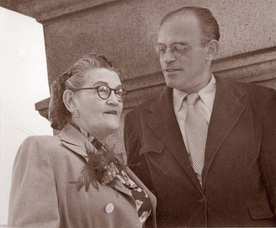 Solomon Auerbach and his mother
Solomon Auerbach and his mother(Jesse Auerbach)
Recollections
Adventures of the Southern Worker
By Patricia Mitchell
In the 1930s the communist paper titled Southern Worker was an underground operation that eluded police and vigilantes who tried desperately to shut it down. Printed and edited in Chattanooga and datelined Birmingham, the paper was run by former Daily Workerbeditors Solomon and Isabelle Auerbach who moved to Birmingham from New York City and started the paper with just two hundred dollars. Sold for two cents a copy, the paper gave a voice to the abuse of labourers and the plight of the unemployed in the South.
Additional Information
The following articles in the Encyclopedia of Alabama will also be of interest:
About the Author
Patricia Mitchell is an undergraduate in English literature at the University of Alabama. She works as an Editorial Assistant at the University of Alabama Press.
Adventures of the Southern Worker
By Patricia Mitchell
In the 1930s the communist paper titled Southern Worker was an underground operation that eluded police and vigilantes who tried desperately to shut it down. Printed and edited in Chattanooga and datelined Birmingham, the paper was run by former Daily Workerbeditors Solomon and Isabelle Auerbach who moved to Birmingham from New York City and started the paper with just two hundred dollars. Sold for two cents a copy, the paper gave a voice to the abuse of labourers and the plight of the unemployed in the South.
Additional Information
The following articles in the Encyclopedia of Alabama will also be of interest:
- Organized Labor in Alabama
- Tennessee Coal, Iron and Railroad (TCI)
- International Union of Mine, Mill, and Smelter Workers of Alabama
- Gadsden Times Reports Strike (image)
About the Author
Patricia Mitchell is an undergraduate in English literature at the University of Alabama. She works as an Editorial Assistant at the University of Alabama Press.
Reading the Southern Past
Eugene Sledge On War And Healing
By Stephen Goldfarb
After several years of fighting the Japanese in the South Pacific, Eugene Sledge had a difficult adjustment returning to civilian life in the fall of 1946. These trials are explored in his memoirs. His first volume, With the Old Breed at Peleliu and Okinawa (Presidio Press, 1981) relates the hard-learned lessons of war. His second volume, China Marine (University of Alabama Press, 2002) captures the difficulties of readjusting to daily life after battle.
Additional Information
The following articles in the Encyclopedia of Alabama will also be of interest:
Multimedia:
About the Author
Stephen Goldfarb holds a PhD in the history of science and technology. He retired from a public library in 2003.
Eugene Sledge On War And Healing
By Stephen Goldfarb
After several years of fighting the Japanese in the South Pacific, Eugene Sledge had a difficult adjustment returning to civilian life in the fall of 1946. These trials are explored in his memoirs. His first volume, With the Old Breed at Peleliu and Okinawa (Presidio Press, 1981) relates the hard-learned lessons of war. His second volume, China Marine (University of Alabama Press, 2002) captures the difficulties of readjusting to daily life after battle.
Additional Information
The following articles in the Encyclopedia of Alabama will also be of interest:
Multimedia:
- Eugene B. Sledge in 1982
- Grave of Eugene B. Sledge
- Eugene Sledge and Students
- Eugene Sledge on Okinawa 1945
About the Author
Stephen Goldfarb holds a PhD in the history of science and technology. He retired from a public library in 2003.
